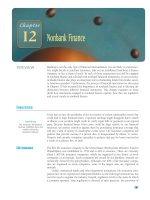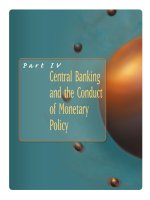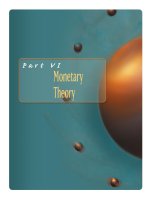Money banking and the financial system 1e by hubbard and OBrien chapter 03
Bạn đang xem bản rút gọn của tài liệu. Xem và tải ngay bản đầy đủ của tài liệu tại đây (547.53 KB, 53 trang )
R. GLENN
HUBBARD
ANTHONY PATRICK
O’BRIEN
Money,
Banking, and
the Financial System
© 2012 Pearson Education, Inc. Publishing as Prentice Hall
CHAPTER
3
Interest Rates and Rates of Return
LEARNING OBJECTIVES
After studying this chapter, you should be able to:
3.1
Explain how the interest rate links present value with future value
3.2
Distinguish among different debt instruments and understand how their prices are determined
3.3
Explain the relationship between the yield to maturity on a bond and its price
3.4
Understand the inverse relationship between bond prices and bond yields
3.5
Explain the difference between interest rates and rates of return
3.6
Explain the difference between nominal interest rates and real interest rates
© 2012 Pearson Education, Inc. Publishing as Prentice Hall
CHAPTER
3
Interest Rates and Rates of Return
BANKS IN TROUBLE
•
During the financial crisis, the number of insolvent banks increased sharply.
•
With the collapse of the housing market, increasing numbers of homeowners had stopped making payments on their mortgage
loans. Banks that held these loans saw their value drop.
•
Mortgage loans that were turned into mortgage-backed securities, similar to bonds, declined by 50% or more during 2008 and
2009.
•
Banks had badly misjudged both the default risk and the interest-rate risk on these bonds.
•
An Inside Look at Policy on page 78 discusses the performance of the bond market through 2010.
© 2012 Pearson Education, Inc. Publishing as Prentice Hall
3 of 53
Key Issue and Question
Issue: During the financial crisis, soaring interest rates on assets such as mortgage-backed securities caused their prices
to plummet.
Question: Why do interest rates and the prices of financial securities move in opposite directions?
© 2012 Pearson Education, Inc. Publishing as Prentice Hall
4 of 53
3.1
Learning Objective
Explain how the interest rate links present value with future value.
© 2012 Pearson Education, Inc. Publishing as Prentice Hall
5 of 53
Why Do Lenders Charge Interest on Loans?
The interest rate on a loan should cover the opportunity cost of supplying credit, particularly, the costs associated with three factors:
•
Compensation for inflation: if prices rise, the payments received will buy fewer goods and services.
•
Compensation for default risk: the borrower might default on the loan.
•
Compensation for the opportunity cost of waiting for the money to be paid back.
The Interest Rate, Present Value, and Future Value
© 2012 Pearson Education, Inc. Publishing as Prentice Hall
6 of 53
Most Financial Transactions Involve Payments in the Future
The importance of the interest rate comes from the fact that most financial transactions involve payments in the future; the interest rate
provides a link between the financial present and the financial future.
The Interest Rate, Present Value, and Future Value
© 2012 Pearson Education, Inc. Publishing as Prentice Hall
7 of 53
Compounding and Discounting
Future value The value at some future time of an investment made today.
If:
i = the interest rate
Principal = the amount of your investment (your original $1,000)
FV = the future value (what your $1,000 will have grown to in one year)
then we can rewrite the expression as:
Compounding for More Than One Period
Compounding The process of earning interest on interest as savings accumulate over time.
If you invest $1,000 for n years, where n can be any number of years, at an interest rate of 5%, then at the end of n years, you will have:
The Interest Rate, Present Value, and Future Value
© 2012 Pearson Education, Inc. Publishing as Prentice Hall
8 of 53
Solved Problem
3.1A
Comparing Investments
Suppose you are considering investing $1,000 in one of the following bank CDs:
•
First CD, which will pay an interest rate of 4% per year for three years
•
Second CD, which will pay an interest rate of 10% the first year, 1% the second year, and 1% the third year
Which CD should you choose?
The Interest Rate, Present Value, and Future Value
© 2012 Pearson Education, Inc. Publishing as Prentice Hall
9 of 53
Solved Problem
3.1A
Comparing Investments
Solving the Problem
Step 1 Review the chapter material.
Step 2 Calculate the future value of your investment with the first CD.
Principal = $1,000, i = 4%, n = 3 years
3
FV = $1,000 x (1 + 0.04) = $1,124.86
Step 3
Calculate the future value of your investment with the second CD and decide which CD you should choose.
Principal = $1,000, i1 = 10%, i2 = 1%, i3 = 1%, n = 3 years
FV = $1,000 x (1 + 0.10) x (1 + 0.01) x (1 + 0.01) = $1,122.11
Decision: You should choose the investment with the highest future value, so you should choose the first CD.
The Interest Rate, Present Value, and Future Value
© 2012 Pearson Education, Inc. Publishing as Prentice Hall
10 of 53
An Example of Discounting
Funds in the future are worth less than funds in the present, so they have to be reduced, or discounted, to find their present value.
Present value The value today of funds that will be received in the future.
Time value of money The way that the value of a payment changes depending on when the payment is received.
Discounting The process of finding the present value of funds that will be received in the future.
The Interest Rate, Present Value, and Future Value
© 2012 Pearson Education, Inc. Publishing as Prentice Hall
11 of 53
Some Important Points about Discounting
1. Present value is sometimes referred to as “present discounted value.”
2. The further in the future a payment is to be received, the smaller its present value (See Table 3.1).
3. The higher the interest rate used to discount future payments, the smaller the present value of the payments (See Table 3.1).
4. The present value of a series of future payment is simply the sum of the discounted value of each individual payment.
The Interest Rate, Present Value, and Future Value
© 2012 Pearson Education, Inc. Publishing as Prentice Hall
12 of 53
Solved Problem
3.1B
Valuing a Contract
Jason Bay played the 2009 baseball season with the Boston Red Sox.
When he became a free agent, the Red Sox offered him a contract for $15 million per year for four years. The New York Mets offered him
a contract that would pay him a total of $66 million.
According to sportswriter Buster Olney: “The Mets’ offer to Jason Bay is heavily backloaded, to the point that the true value of the fouryear [contract] falls to within the range of the offer he turned down from the Red Sox.”
What does Olney mean by the payments in the Mets’ contract being “backloaded”? What does he mean by the “true value” of the
contract?
How would backloading the payments affect the true value of the contract?
The Interest Rate, Present Value, and Future Value
© 2012 Pearson Education, Inc. Publishing as Prentice Hall
13 of 53
Solved Problem
3.1B
Valuing a Contract
Solving the Problem
Step 1 Review the chapter material.
Step 2 Explain what Olney means by “backloaded” and “true value.”
A “backloaded” contract means that the Mets offered Jason Bay lower salaries in the first years and higher salaries in the later years of the contract. The
“true value” probably refers to the present value of the contract.
Step 3
Explain how backloading affects the value of the contract.
We know that the present value of payments is lower the further away in time those payments are made. So, if the Mets’ contract pays Bay most of the $66
million in the third and fourth years of the contract, it could have a present value similar to the Red Sox contract that paid $60 million spread out as four
annual $15 million payments.
The Interest Rate, Present Value, and Future Value
© 2012 Pearson Education, Inc. Publishing as Prentice Hall
14 of 53
A Brief Word on Notation This book will always enter interest rates in numerical calculations as decimals. For instance, 5% will be 0.05,
not 5.
Discounting and the Prices of Financial Assets
Discounting gives us a way of determining the prices of financial assets. By adding up the present values of all the payments, we have
the dollar amount that a buyer will pay for the asset. In other words, we have determined the asset’s price.
The Interest Rate, Present Value, and Future Value
© 2012 Pearson Education, Inc. Publishing as Prentice Hall
15 of 53
3.2
Learning Objective
Distinguish among different debt instruments and understand how their prices are determined.
© 2012 Pearson Education, Inc. Publishing as Prentice Hall
16 of 53
The price of a financial asset is equal to the present value of the payments to be received from owning it.
Debt instruments (also known as credit market instruments or fixed income assets) Methods of financing debt, including simple
loans, discount bonds, coupon bonds, and fixed payment loans.
Equity A claim to part ownership of a firm; common stock issued by a corporation.
Debt Instruments and Their Prices
© 2012 Pearson Education, Inc. Publishing as Prentice Hall
17 of 53
Loans, Bonds, and the Timing of Payments
In this section, we discuss four basic categories of debt instruments:
1.
Simple loans
2.
Discount bonds
3.
Coupon bonds
4. Fixed-payment loans
Debt Instruments and Their Prices
© 2012 Pearson Education, Inc. Publishing as Prentice Hall
18 of 53
Simple Loan
Simple loan A debt instrument in which the borrower receives from the lender an amount called the principal and agrees to repay the
lender the principal plus interest on a specific date when the loan matures.
After one year, Nate’s would repay the principal plus interest: $10,000 + ($10,000 × 0.10), or $11,000.
Debt Instruments and Their Prices
© 2012 Pearson Education, Inc. Publishing as Prentice Hall
19 of 53
Discount Bond
Discount bond A debt instrument in which the borrower repays the amount of the loan in a single payment at maturity but receives less
than the face value of the bond initially.
The lender receives interest of $10,000 - $9,091 = $909 for the year. Therefore, the interest rate is $909/$9,091 = 0.10, or 10%.
Debt Instruments and Their Prices
© 2012 Pearson Education, Inc. Publishing as Prentice Hall
20 of 53
Coupon Bonds
Coupon bond A debt instrument that requires multiple payments of interest on a regular basis, such as semiannually or annually, and a
payment of the face value at maturity.
Terminology of coupon bonds:
•
Face value, or par value, is the amount to be repaid by the bond issuer (the borrower) at maturity.
•
The coupon is the annual fixed dollar amount of interest paid by the issuer of the bond to the buyer.
•
The coupon rate is the value of the coupon expressed as a percentage of the par value of the bond.
•
The current yield is the value of the coupon expressed as a percentage of the current price.
Debt Instruments and Their Prices
© 2012 Pearson Education, Inc. Publishing as Prentice Hall
21 of 53
Coupon Bonds
•
Maturity is the length of time before the bond expires and the issuer makes the face value payment to the buyer.
•
For example, if IBM issued a $1,000 30-year bond with a coupon rate of 10%, it would pay $100 per year for 30 years and a final
payment of $1,000 at the end of 30 years. The timeline on the IBM coupon bond is:
Debt Instruments and Their Prices
© 2012 Pearson Education, Inc. Publishing as Prentice Hall
22 of 53
Fixed-Payment Loan
Fixed-payment loan A debt instrument that requires the borrower to make regular periodic payments of principal and interest to the
lender.
•
For example, if you are repaying a $10,000 10-year student loan with a 9% interest rate, your monthly payment is approximately
$127. The time line of payments is:
Debt Instruments and Their Prices
© 2012 Pearson Education, Inc. Publishing as Prentice Hall
23 of 53
Making the Connection
Do You Want the Principal or Do You Want the Interest?
Creating New Financial Instruments
•
Back when the U.S. Treasury offered only short-term discount bonds, investors were seeking to benefit from longer terms knowing
the exact return if they held the bonds to maturity.
•
In 1982, Merrill Lynch created the TIGR (Treasure Investment Growth Receipt), which is a discount bond that works like a Treasury
Bill.
•
Two years later, the Treasury introduced its own version called STRIPS (Separate Trading of Registered Interest and Principal
Securities). These bonds allowed investors to buy each interest payment and the face value of the bond.
•
Individuals can obtain long-term discount bonds as well as the regular Treasury coupon bonds, thereby increasing their options for
investment.
Debt Instruments and Their Prices
© 2012 Pearson Education, Inc. Publishing as Prentice Hall
24 of 53
3.3
Learning Objective
Explain the relationship between the yield to maturity on a bond and its price.
© 2012 Pearson Education, Inc. Publishing as Prentice Hall
25 of 53









